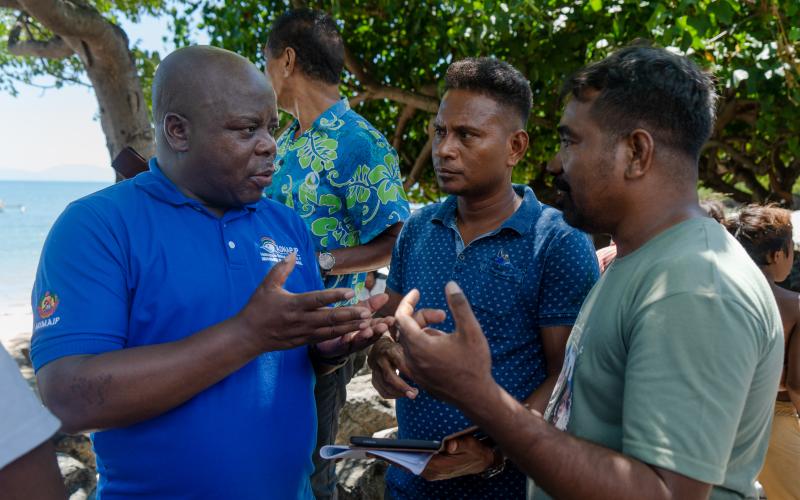
Kenya, Mozambique, and Tanzania are looking to Timor-Leste’s expertise in developing and implementing digital monitoring of small-scale fisheries to help transform their local systems.
Government representatives from Kenya, Mozambique, and Tanzania’s Zanzibar region traveled to Timor-Leste in April 2024 to share experiences and learn from each other about gathering data on small-scale fisheries (SSF).
“This visit to Timor-Leste is part of South-South collaboration and knowledge exchange,” said Marcos da Cruz, the Timor-Leste Minister for Agriculture, Livestock, Fisheries and Forestry.
“The goal is to share lessons, stories and knowledge about digital transformation [for SSF monitoring].”
The minister spoke at the opening of the Digital Fisheries Monitoring Knowledge Exchange workshop, held in Dili on 23 April 2024 and attended by over 60 participants.
The workshop was part of a three-day visit organized by the Asia-Africa BlueTech Superhighway (AABS) project, which is funded by the UK Government and led by WorldFish in collaboration with a host of partners.

Common Challenges with Monitoring
In the workshop, the delegates presented their specific fisheries contexts and struggles in monitoring SSF. This included challenges with data, systems, capacity and knowledge.
“In Kenya, we have 213 landing sites, so it’s difficult to monitor all sites. And there are sometimes errors in data entry,” said Dr. Gladys Okemwa, Principal Scientist, Kenya Marine and Fisheries Research Institute (KMFRI). “Cost is another barrier. We are looking for registered technologies that are affordable to fishers so we can pilot and adopt them.”
In Mozambique, the government developed its PESCART monitoring system using Microsoft Access in 1997. “But because the software is outdated, the system no longer works perfectly,” said Pedro Pires of the Mozambican Ministry of Sea, Inland Waters and Fisheries. “We have been struggling to finish converting to a modern database to use the FAO’s Open Artfish methodology.”
The Zanzibar delegates spoke about limited capacity. “There is limited knowledge, skills, human resources, and money,” said Nassor Abdalla Nassor, Head of Fisheries Statistics and Information Systems, Ministry of Blue Economy and Fisheries, Zanzibar.
Despite their diverse contexts, experiences and expertise, the participants acknowledged they faced similar bottlenecks such as low digital literacy and inclusion, lack of internet access, and lack of funding continuity.

Replicating the Low-Cost Peskas System to Improve SSF Insights
The workshop showcased Timor-Leste’s digital monitoring system for SSF, Peskas. Developed by WorldFish and co-designed with the General Directorate of Fisheries, it uses catch data collected by local enumerators and vessel tracking data to show fishing trends over time and space.
“Peskas provides near-real-time monitoring that’s low cost and open access,” said Minister da Cruz. “It is a cost-effective system that is financially feasible and sustainable and can be replicated in other countries.”
Phase 1 of the AABS project (2023-27), under the Digital Coasts work package, involves working with the three African countries to adapt components of Peskas to bolster their local monitoring systems.
Workshop participants discussed which parts of Peskas could be applied to fisheries monitoring systems in Kenya, Mozambique and Zanzibar to address critical challenges.
In Mozambique, participants said upgrading to a cloud-based database will enable quick insights using Peskas’ analytics and dashboard functions.
“In Kenya, Peskas can help to validate our data so we can deal with errors before they come out,” explained Paul Alex Lukhwenda, Senior Fisheries Scientist at Kenya Fisheries Service. It could also generate real-time information and dashboards, providing beach management units with insights they currently lack.

In Zanzibar, Peskas vessel monitoring components could provide high-resolution data for marine spatial planning to support habitat and resource mapping around islands. It is also possible to build nutrition models to build an understanding of fisheries potential in real time for local nutrition security.
These efforts will help ensure fisheries stakeholders in Kenya, Mozambique, and Zanzibar have access to and skills in using data to make decisions.
“Having data on SSF helps to paint a picture of what is happening so policymakers, fishers, and traders have information to make decisions,” said Dr Alex Tilley, Senior Research Scientist at WorldFish, at the workshop's conclusion.
“It would be great to develop a community of practice or platform around digital fisheries monitoring or transformation so we can continue to learn from each other. Let’s keep the dialogue open.”
The next step is applying the lessons from Timor’s experience in the three African countries. Gathering existing data and workflows in the countries, the AABS team will work with the local stakeholders to design, contextualize, and test versions of Peskas modules according to the objectives and aspirations of the local partnering communities.
